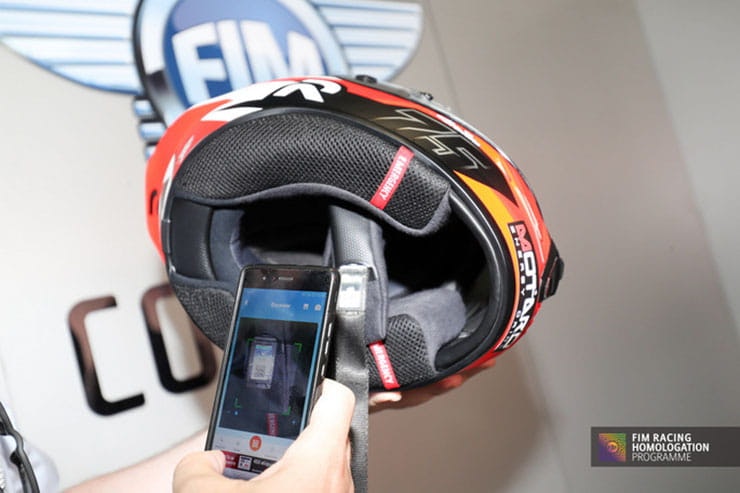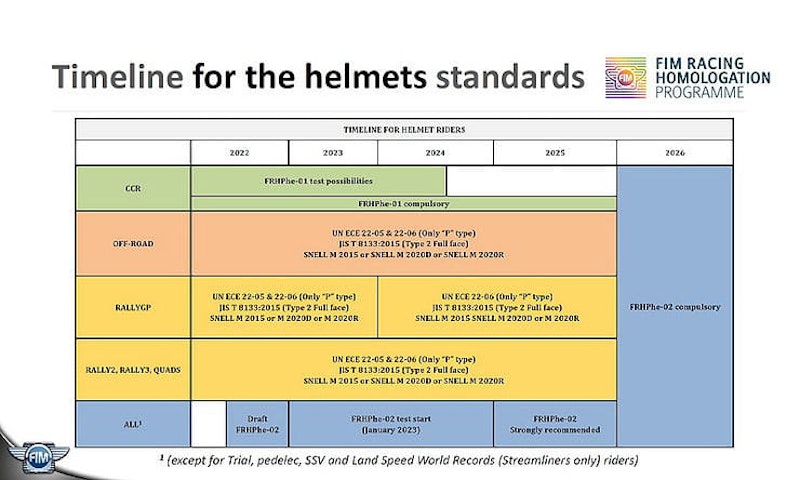FIM launches second phase of helmet safety standards
By Ben Purvis
Motorcycle Journalist
06.12.2022
In 2019 the FIM mandated high-specification ‘FRHPhe-01’ helmets – meeting standards that exceed UN ECE 22.06 or Snell M2020 regulations – for MotoGP riders, expanding to other FIM-organised circuit racing in 2020. Now it’s expanded the programme with a new FRHPhe-02 standard that covers off-road as well as on-track lids.
As well as being above the existing standards that manufacturers need to meet to sell helmets for road use, FRHPhe-02 exceeds the previous FRHPhe-01 rules and the testing protocol has been expanded to cover additional helmet types so it can apply to off-road competition.
According to the FIM, the FRHPhe-02 (FRHPhe stands for ‘FIM Racing Homologation Programme for helmets’) rules require that helmets must survive 9 to 13 random impacts at any of 22 established locations around the helmet surface, as before, as well as new tests including impacts against oblique and hemispherical anvils and checks that the cheek pads can be removed quickly. For FRHPhe-02 there’s also a new ‘Skull Fracture Criterion’ (SFC), defined as the average linear acceleration over a calculated time interval.
The key tests in the FRHPhe-02 standard are four impacts against a flat anvil from 17 possible impact points (compared to 3 impacts from 12 possible points in FRHPhe-01 and ECE 22-06 standards), all at a speed of 8.2m/s, which is the highest used in the current tests. There are also 4 impacts from 17 possible points against a hemispherical anvil at 7.5m/s – which aren’t in the existing FRHPhe-01 or other standards. As well as meeting the FRHPhe-02 standards, homologated helmets also have to achieve UN ECE 22-06, Snell M 2015, M 2020D or M 2020R, or JIS T 8133:2015 certification.
The new FRHPhe-02 standard is due to be mandatory for all helmets used in FIM competition (with a few exceptions including trials riders and riders of streamliners in land speed records) from 2026, with a ‘strong recommendation’ that the standards are followed in 2025.
Although not directly affecting the standards that the helmets road rider wear, the FRHPhe-02 rules are sure to change some of the helmets that are on the market and many companies’ top-of-the-range lids, aimed at racers as well as road riders, will have to meet the FRHPhe-02 standard for the competition portion of their target markets. For compliance, as with FRHPhe-01 lids, the FRHPhe-02 helmets will have a QR code sewn into the chinstrap, which can be scanned at each FIM competition to track each helmet individually and ensure its validity.
Jorge Viegas, FIM President, said: “The first aim of the FIM was always the safety for its riders. After the experience of phase 1 of the FIM Racing Homologation Programme for helmets (FRHPhe-01), the FIM and DORNA are fully satisfied with the efficient results for the safety of riders. The FRHPhe-02 represents a milestone to increase the level of safety for our riders, and to introduce an FIM standard for Off-Road riders. The FIM got involved in this project, with a lot of work alongside the helmet manufacturers, our promoters, and with our Technical Stewards feedback. I expect that some manufacturers will propose helmets compliant with FRHPhe-02 to our riders before the target of the 2026 season, and they could manufacture them not only for FIM championships but also for national federation events, for safety in Off-Road.”
Carmelo Ezpeleta, Dorna CEO, adds: “The helmet is undoubtedly one of the most important pieces of equipment for the safety of riders, so it is important that the FIM is fully committed to the homologation and evolution of this crucial element. Moreover, it is good to see that all the stakeholders involved in the world championship are working together towards a common goal: increased safety, not only of the tracks but also of the riders on an individual level.”
Share on social media:

